 ?Mathematical formulae have been encoded as MathML and are displayed in this HTML version using MathJax in order to improve their display. Uncheck the box to turn MathJax off. This feature requires Javascript. Click on a formula to zoom.
?Mathematical formulae have been encoded as MathML and are displayed in this HTML version using MathJax in order to improve their display. Uncheck the box to turn MathJax off. This feature requires Javascript. Click on a formula to zoom.Abstract
The Cauchy problem for the Helmholtz equation is considered. It was demonstrated in a previous paper by the authors that the alternating algorithm suggested by V.A. Kozlov and V.G. Maz’ya does not converge for large wavenumbers k in the Helmholtz equation. Here, we present some simple modifications of the algorithm which may restore the convergence. They consist of the replacement of the Neumann–Dirichlet iterations by the Robin–Dirichlet ones which repairs the convergence for less than the first Dirichlet–Laplacian eigenvalue. In order to treat large wavenumbers, we present an algorithm based on iterative solution of Robin–Dirichlet boundary value problems in a sufficiently narrow border strip. Numerical implementations obtained using the finite difference method are presented. The numerical results illustrate that the algorithms suggested in this paper, produce convergent iterative sequences.
1. Introduction
Let be a bounded domain in
with a Lipschitz boundary
and let
be the exterior unit normal to
. Let
also be divided into two disjoint parts
and
such that
is Lipschitz; see illustration in Figure on the left. We consider the Cauchy problem of finding a real-valued solution u to the problem
(1)
(1)
where is the wavenumber,
denote the outward normal derivative and f and g are specified Cauchy data. This problem plays an important role in the study of problems related to acoustic and electromagnetic wave propagation, for example, the determination of a radiation field surrounding a source of radiation [Citation1], the detection of the source of acoustical noise [Citation2], the detection of surface vibrations from interior acoustical pressure [Citation3], etc.
This problem is ill-posed in the sense of Hadamard. The classical numerical methods are thus inappropriate for solving the problem. Different regularization methods such as the potential function method [Citation4], the modified Tikhonov regularization method [Citation5,Citation6], the truncation method [Citation7], the method of approximate solutions [Citation1], the wavelet moment method [Citation8], the method of fundamental solutions [Citation9], the conjugate gradient methods with the boundary element method [Citation10,Citation11], an alternating algorithm [Citation12,Citation13] and the accelerated alternating method [Citation14] have been considered for solving the Cauchy problem for the Helmholtz equation.
Figure 1. Description of the domain considered here and the description of the domain with the interior boundary.

If then one can apply the alternating algorithm suggested in [Citation15,Citation16] which consists of iterative solution of the Neumann–Dirichlet problems. It has been shown in [Citation13, Section 1.3] that this alternating procedure does not always converge for large values of
in the Helmholtz equation. We therefore proposed in [Citation13] a modification of the alternating algorithm that we used to solve problem (Equation1
(1)
(1) ), based on an introduction of an auxiliary boundary and a positive parameter, which are chosen to guarantee positivity of a certain quadratic form associated with the Helmholtz operator, our auxiliary boundary and parameter. It was proved in [Citation13] that the modified algorithm is convergent but the convergence of this modified algorithm is slow. However, since the quadratic form associated with the problem is positive, we can introduce a scalar product that gives us a natural framework that can be used to implement more sophisticated regularization methods. This was done in [Citation14,Citation17] where we showed that the conjugate gradient method can be used for solving the Cauchy problem for the Helmholtz equation efficiently. Since the conjugate gradient iterations have regularizing effect, see [Citation18], we could also solve the problem with noisy data.
In [Citation13,Citation14] it became clear that the main reason of the improved convergence is played by the replacement of the Neumann–Dirichlet iterations by the Robin–Dirichlet ones. In this paper, we present some simple modifications of the algorithm which may restore the convergence of the alternative algorithm from [Citation15,Citation16]. They consist of the replacement of the Neumann–Dirichlet iterations by the Robin–Dirichlet ones on or
or on both
and
which repairs the convergence for
less than the first Dirichlet–Laplacian eigenvalue. In order to treat large wavenumbers, we present an algorithm based on iterative solution of Robin–Dirichlet boundary value problems in a sufficiently narrow border strip.
An important advantage of the proposed algorithms is that they can be readily applied to more general problems. First, we can treat more general second-order elliptic equations in divergence form with variable coefficients, i.e.
and
where A is a bounded matrix function with variable coefficients and k is a bounded measurable function. Secondly, we can reconstruct elastic oscillations, with a fixed frequency, in non-homogeneous and non-isotropic media by boundary measurements, i.e.
and
where is the stress tensor,
and
are space dependent functions, and
is the displacement vector.
2. Description of the algorithms
In this section, we describe several iterative methods for solving the problem (Equation1(1)
(1) ). The methods are based on solving two well-posed boundary value problems for the original Helmholtz equation. In each iteration, we fix one of the known Cauchy data and choose the other one in an appropriate way so that the resulting boundary value problem is well posed. We also discuss the choice of the interior boundary
and the positive constant
which ensures the validity of inequality (Equation6
(6)
(6) ) in Section 2.2. For solving problem with mixed boundary conditions involved in each iterative method described below, we refer to [Citation19–Citation22] and to [Citation23] with superconvergence.
Before proceeding we recall the following definition:
Definition 2.1:
A function is called a weak solution to the Helmholtz equation in
if
for all such that
on
.
2.1. The Robin–Dirichlet algorithm
In the first iterative algorithm, we alternate the Robin–Dirichlet boundary conditions on . The Dirichlet–Neumann boundary conditions are also alternated on
. In order to formulate the methods, let us first assume that one can choose a positive constant
so that
(2)
(2)
for all .
As it was shown in [Citation13, Lemma 2.1], the inequality (Equation2(2)
(2) ) is valid for sufficiently large
if and only if the first integral in (Equation2
(2)
(2) ) is positive on non-zero functions from
vanishing on
. We note that the correct formulation of [Citation13, Theorem 2.2] may be found in [Citation24]. Consider now the following boundary value problems:
(3)
(3)
and(4)
(4)
Here, and
are the data in (Equation1
(1)
(1) ). For
and
, problems (Equation3
(3)
(3) ) and (Equation4
(4)
(4) ) are well posed and their weak solutions are defined below. Let us mention that in the following,
and
denote the dual spaces to
and
, respectively.
Definition 2.2:
Let and
. We call
a weak solution to problem (Equation3
(3)
(3) ) if u satisfies
for every function such that
on
and
on
.
In a similar way, we give the definition of a weak solution to (Equation4(4)
(4) ).
Definition 2.3:
Let and
. We call
a weak solution to problem (Equation4
(4)
(4) ) if it satisfies
for every function such that
on
and
on
.
The algorithm for solving (Equation1(1)
(1) ) is then described as follows:
| (1) | The first approximation | ||||
| (2) | Having constructed | ||||
| (3) | We then obtain | ||||
Theorem 2.4:
Suppose that is a positive constant chosen so that the positivity of the quadratic form (Equation2
(2)
(2) ) is fulfilled. Let
and
, and let
be the solution to problem (Equation1
(1)
(1) ). Then, for every
, the sequence
, obtained using the algorithm described above, converges to u in
.
One can also consider the following two alternatives for the algorithm presented above:
| (I) | Assume that there exists a positive constant | ||||
| (II) | Another alternative algorithm requires the existence of two positive constants | ||||
2.2. The Robin–Dirichlet algorithm with interior boundary
The algorithm proposed in the previous section may also diverge for large values of in the Helmholtz equation. We shall therefore consider a variation of this method. The new method consists of introducing an artificial interior boundary
inside
and a positive constant
. We now solve the Helmholtz equation in a narrow border strip between
and
with the Dirichlet–Neumann boundary conditions on
and
and the Robin–Dirichlet boundary conditions on
.
Assume that is a subdomain of
with a Lipschitz boundary
. Define
; see Figure on the right. Assume also that
is a positive constant chosen so that
(6)
(6)
for all ,
. Again, using [Citation13, Lemma 2.1] one can show that the validity of (Equation2
(2)
(2) ), for large
, is equivalent to positivity of the first integral in (Equation2
(2)
(2) ) for non-zero
vanishing on
. The new alternating procedure involves the following boundary value problems:
(7)
(7)
and(8)
(8)
The algorithm thus consists of solving in an alternating way two well-posed boundary value problems (Equation7(7)
(7) ) and (Equation8
(8)
(8) ). We define their weak solutions.
Definition 2.5:
Let ,
and
. We call a function
a weak solution to problem (Equation7
(7)
(7) ) if it satisfies
for every function such that
on
and
on
.
In a similar way, we define a weak solution to (Equation8(8)
(8) ).
Definition 2.6:
Let ,
and
. We call a function
a weak solution to problem (Equation8
(8)
(8) ) if it satisfies
for every function such that
on
and on
,
on
and
on
.
The algorithm for solving (Equation1(1)
(1) ) is described as follows:
| (1) | The first approximation | ||||
| (2) | Having constructed | ||||
| (3) | We then obtain | ||||
Theorem 2.7:
Suppose that assumptions on the choice of the interior boundary and the constant in Section 2.3 are fulfilled and the positivity condition (Equation6
(6)
(6) ) holds. Let
and
, and let
be the solution to problem (Equation1
(1)
(1) ). Then, for every
and every
, the sequence
, obtained using the alternating algorithm described in Section 2.2, converges to u in
.
The proof of this theorem can be carried out in a similar way as in [Citation13, Section 3].
2.3. Sufficient condition for 
 to be positive definite
to be positive definite
In this section, we discuss the choice of the interior boundary and the positive constant
which ensures the validity of (Equation6
(6)
(6) ). We consider the two-dimensional case.
Let denote the length of the boundary
. Assume that the curve
is parametrized in terms of the arc length s with
and introduce the parametrization
, counterclockwise. In that case, the unit tangent and the unit normal are given by
and
, respectively. At any point t;
, inside
, we thus have the following parametrization:
Let us define(9)
(9)
Using the parametrization described above, we can rewrite (Equation9(9)
(9) ) as
(10)
(10)
where is the curvature of
at the point r(s). In order for relation (Equation6
(6)
(6) ) to hold, we shall determine h and
so that
. From (Equation10
(10)
(10) ), it is sufficient to determine h and
so that
(11)
(11)
holds for all non-zero . Then (Equation11
(11)
(11) ) follows from
where
We assume that h is sufficiently small. Consider the spectral problem(12)
(12)
Consider the case when and put
. Solving problem (Equation12
(12)
(12) ), we find that
(13)
(13)
Therefore the first positive root of (Equation13(13)
(13) ) lies in the interval
(14)
(14)
We see that the positivity condition holds and conclude that the value of h must be so that (Equation12(12)
(12) ) is satisfied. Denote by
the least eigenvalue. Then if
the inequality (Equation11(11)
(11) ) is satisfied.
3. Numerical experiments
In this section, we present some numerical results that illustrate the algorithms developed in Section 2. We only investigate the case of exact data. For our tests, we start by finding the value of the wavenumber in the Helmholtz equation for which the iterative procedure studied in [Citation15] does not converge. This algorithm is described as the algorithm in Section 2.1 where the Robin boundary condition in problem (Equation3
(3)
(3) ) is replaced by the Neumann boundary condition instead. We then apply the iterative methods presented in Sections 2.1 and 2.2.
For the numerical implementation of these methods, we solve problem (Equation1(1)
(1) ) in a circular domain
, where
is the radius of the circle. The boundaries
and
are given by
respectively. We should mention here that various choices of have been considered in order to investigate the ill-posedness of the Cauchy problem with respect to the lengths of the known and unknown parts of the boundary
and
, respectively. The interior boundary described in Section 2.2 is given by
, where
is the radius for the inner circle.
The auxiliary problems involved in the description of each method are solved by a finite difference method. For all the boundary value problems, we discretize the Helmholtz equation(15)
(15)
together with the periodicity condition(16)
(16)
to ensure the continuity at the end points. Depending on the algorithm, we also need to discretize the boundary conditions for the inner and outer circles corresponding to and
, respectively. These boundary conditions are the Dirichlet boundary condition:
(17)
(17)
the Neumann boundary condition:(18)
(18)
and the Robin boundary condition:(19)
(19)
3.1. Finite difference approximation
We discretize the problem in polar coordinates. We consider the grid points as , where
and
. The grid size in the r and
coordinates will be given by
and
, respectively. Let
denote the discrete approximation to
. We approximate the first- and second-order derivatives of the function u with respect to r by the centred differences
respectively. Similarly, the second-order derivative of the function u with respect to can be defined. As a result, the finite difference approximation of the Helmholtz equation (Equation15
(15)
(15) ) at each interior grid point corresponding to (i, j),
and
thus simplifies to
where
The periodicity condition (Equation16(16)
(16) ) gives
Since there is only one point at the origin denoted by ,
, the discretization at that point is given by:
For the Dirichlet boundary conditions (Equation17(17)
(17) ), we get the discretization of the form
where corresponds to the index for
. The discretizations of the Neumann boundary condition (Equation18
(18)
(18) ) obtained using the forward difference on
and backward difference on
are given by
and
respectively. This particular choice means that we approximate the Neumann boundary condition with accuracy . The discretization of the Robin boundary conditions is obtained as a combination of the Neumann and Dirichlet discretizations.
Since for each of the iterative methods considered here, we only solve two boundary value problems, the discretization of each method leads to two different types of linear systems ,
, where each
is a large sparse matrix of size
, and each
is a vector that contains the boundary data values. Each system of equations is solved using the LU factorization. The advantage of these methods is that since the matrix
,
does not depend on the boundary data, we can save the matrix
,
and its sparse LU factorization between iterations. This significantly improves the computational speed.
3.2. The test problem
For the numerical computations, we choose the radius of the circle and the computational grid
and
, in the
- and r-coordinates, respectively. The exact solution
is computed numerically by solving the Helmholtz equation with the Dirichlet boundary condition on
given by
where and
. The exact Neumann boundary data g(x, y) is evaluated numerically from the exact solution
. We observe that as
increases the shape of the function f(x, y) above changes as well as the exact solution (see Figure ) so that the problem becomes difficult to solve. It is therefore difficult to compare the quality of the computed solutions. But we can investigate the convergence or divergence of the algorithms presented in Sections 2.1 and 2.2 with respect to the wavenumber
.
Figure 2. Exact numerical solution obtained by solving the direct problem with the Dirichlet boundary conditions f(x, y) with different wavenumbers
. On the left,
and on the right
.
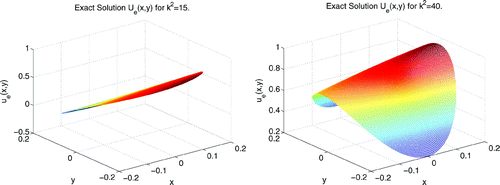
In order to start the iterative algorithms, we also need to choose initial approximations described in each method. For this, we solve the direct problem for the Helmholtz equation with Dirichlet boundary condition on
. The function
is selected by interpolation of the function f using a cubic spline. This function is created so that
on
but with different values on
. The reason to do this is to avoid the discontinuity in the function
at the end points of the boundary
and
that may lead to the Gibbs phenomena. The solution to this direct problem is thus the initial approximation
from which we evaluate initial approximations required by any of the algorithms. It should be noted here that with the choice of
so that
, all the methods considered here produce an iterative sequence that converges to the exact solution. The initial guess
chosen here is not far from the exact solution on
.
Figure 3. Results from the original algorithm when . In the left the convergence history is presented when
. The exact and numerical solutions are presented in the right where the vertical dotted line separates the known and unknown part of the boundary. Here the solid line (–), the dash starred line (–
–), the dashed triangulated line (–
–), the dash squared line (–
–) and the dashed circular line (–
–) correspond the the noise level
,
,
and
, respectively.
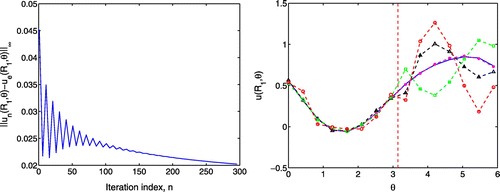
Figure 4. The value of the wavenumber . We alternate the Dirichlet–Neumann conditions on
and the Robin–Dirichlet conditions on
with
. The values of the exact and numerical Dirichlet boundary data are presented on the right and the convergence history is shown on the left. The vertical dotted line separates the known and unknown part of the boundary. For both figures, the solid line (–), the dash starred line (–
–), the dashed triangulated line (–
–), the dash squared line (–
–) and the dashed circular line (–
–) correspond the the noise level
,
,
and
, respectively.
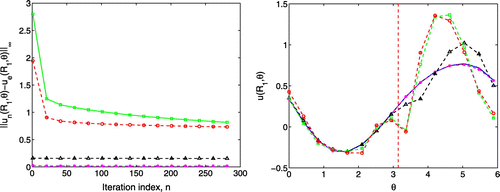
Figure 5. Divergence histories. On the left, the algorithm for which the Neumann–Dirichlet boundary conditions are alternated on and on
diverges for
. On the right, the Dirichlet–Neumann boundary conditions are alternated on
and the Robin–Dirichlet boundary conditions on
. The iterative sequence diverges for
.
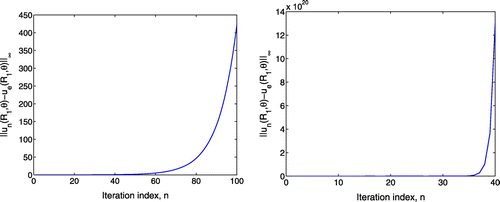
Figure 6. The value of the wavenumber . We alternate the Robin–Dirichlet conditions on
with
and the Dirichlet–Neumann conditions on
. The values of the exact and numerical Dirichlet boundary data are presented on the right and the convergence history is shown on the left. The vertical dotted line separates the known and unknown part of the boundary. The exact and numerical solutions are presented in the right where the vertical dotted line separates the known and unknown part of the boundary. Here the solid line (–), the dash starred line (–
–), the dashed triangulated line (–
–), the dash squared line (–
–) and the dashed circular line (–
–) correspond the the noise level
,
,
and
, respectively.
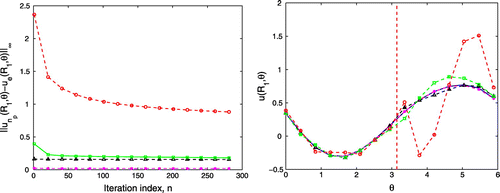
Figure 7. The value of the wavenumber . We alternate the Robin–Dirichlet conditions on
and on
with parameters
and
. The values of the exact and numerical Dirichlet boundary data are presented on the right and the convergence history is shown on the left. The vertical dotted line separates the known and unknown part of the boundary. The exact and numerical solutions are presented in the right where the vertical dotted line separates the known and unknown part of the boundary. The solid line (–), the dash starred line (–
–), the dashed triangulated line (–
–), the dash squared line (–
–) and the dashed circular line (–
–) correspond the the noise level
,
,
and
, respectively.
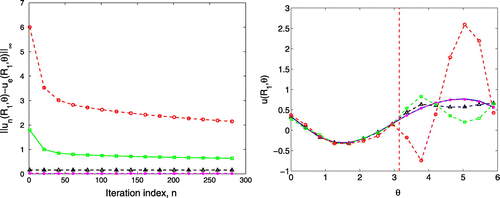
Figure 8. In this figure the value of the wavenumber . We solve the problem in a narrow strip for
and the constant
in the Robin boundary condition. The values of the exact and numerical solutions are presented on the right and the convergence history is shown on the left. The vertical dotted line separates the known and unknown part of the boundary. The exact and numerical solutions are presented in the right where the vertical dotted line separates the known and unknown part of the boundary. Here the solid line (–), the dash starred line (–
–), the dashed triangulated line (–
–), the dash squared line (–
–) and the dashed circular line (–
–) correspond the noise level
,
,
and
, respectively.
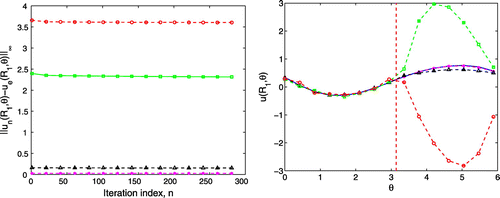
For our numerical tests, we only present the numerical reconstruction of u on since the reconstruction of
on
is more ill-conditioned. This instability may due to the fact that the numerical differentiation in itself is ill-posed; see [Citation18].
3.3. Results and discussion
In the following, we investigate the convergence of the methods presented in Sections 2 with respect to the wavenumber . We consider the case of exact Cauchy data as well as noisy data. The noisy data are obtained by adding a normally distributed random noise of variance
on the data f (x, y) and g(x, y), respectively. We only describe the numerical results obtained when
.
In order to apply our algorithms, we first find the value of the wavenumber for which the alternating algorithm in [Citation15] does not converge. We observe that this method produces a convergent numerical solution when
; see Figure and diverges for
; see Figure on the left. We have noticed that as
increases, the error
oscillates at the beginning of iterations before it becomes stable and decreases slowly; see Figure on the left. We only present the results for exact data, i.e.
. But similar behaviour is observed for noisy data. Therefore, we apply the algorithms described in Sections 2.1 and 2.2 for
. The results for all the four algorithms are summarized in Table .
Table 1. This table presents the convergence and/or divergence of the algorithms presented in this paper with respect to the wavenumber and the choice of the parameters and/or
in the Robin boundary conditions involved for a given method.
We now apply the algorithms developed in Section 2.1 for . The numerical results are presented in Figures –, respectively. These results depend on appropriate choices of the parameters
and/or
in the Robin boundary conditions involved in each method as presented in Table . We observe that replacing the Neumann boundary conditions by the Robin boundary conditions, we improve the convergence of the method for the wavenumber for which the first algorithm fails. We also observe that as
increases, the constant
and/or
in the Robin boundary conditions increases also. For
, the error
is unstable at the first iterations. The algorithm becomes increasingly unstable as
increases and diverges for
, see Figure on the right.
Figure 9. In this figure, we solve the problem in a narrow strip for and the constant
in the Robin boundary condition. The values of the exact (- - -) and numerical (—) solutions are presented on the right and the convergence history is shown on the left. The vertical dotted line separates the known and unknown part of the boundary.
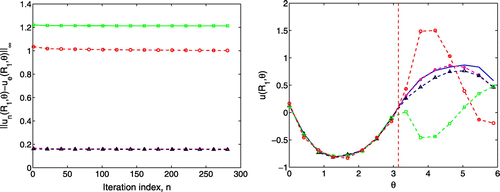
We finally investigate the algorithm presented in Section 2.2 as it is shown in Figures , and Table . Compared to the previous methods, this method is accurate as the wavenumber increases. From the results in Table , we also observe that the constant
in the Robin boundary condition also increases very much as the wavenumber increases.
For all the results presented here, we observe that as the noise level increases, the reconstruction of the numerical solutions becomes difficult. It is thus important to study the regularization effect in the future.
4. Conclusions
It was proved in [Citation13] that the alternating algorithm suggested by V.A. Kozlov and V.G. Maz’ya in [Citation15] does not converge for large values of the wave number in the Helmholtz equation. In this paper, we have considered iterative methods based on replacing Neumann–Dirichlet iterations by the Robin–Dirichlet ones. We observed that the algorithms presented in Section 2.1 may be used to improve the convergence of the algorithms in [Citation15] for solving the Cauchy problem for the Helmholtz equation. As we expected, these algorithms fail to produce a convergent sequence for some large values of the wavenumber . It becomes thus important to consider the algorithm in Section 2.2 based on solving the Cauchy problem for the Helmholtz equation in a narrow strip. The results reported above show that with this new method, the Cauchy problem for the Helmholtz equation is solved for large values in the wavenumber
.
It should be noted here that accurate results were obtained for the case of exact Cauchy data. Thus, we have demonstrated that the proposed methods are all related to positive quadratic forms. This means that we get a scalar product that is natural for the problem. By reformulating the Cauchy problem (Equation1(1)
(1) ) as a linear operator equation, we thus have a natural setting with a scalar product that allows us to compute the adjoint operator by solving a similar boundary value problem. This can be used to implement faster methods, see [Citation14,Citation17], based on the conjugate gradient algorithm. For the same geometry, one can also compare the algorithm in Section 2.2 with our previous algorithm developed in [Citation13].
In our future work, we will investigate the stability of these methods and improve our results in the case of inexact Cauchy data. We will also work to add regularization to the iterative methods. Also we remark that in our iterative methods we need to solve well-posed boundary value for the Helmholtz equation. If an application involves a complicated domain the finite element method may be more suitable to use. This is also something we intend to demonstrate in future papers.
Additional information
Funding
Notes
No potential conflict of interest was reported by the authors.
References
- Regińska T, Regiński K. Approximate solution of a Cauchy problem for the Helmholtz equation. Inverse Prob. 2006;22:975–989.
- Delillo T, Isakov V, Valdivia N, et al. The detection of the source of acoustical noise in two dimensions. SIAM J Appl Math. 2001;61:2104–2121.
- Delillo T, Isakov V, Valdivia N, et al. The detection of surface vibrations from interior acoustical pressure. Inverse Prob. 2003;19:507–524.
- Sun Y, Zhan D, Ma F. A potential function method for the Cauchy problem for elliptic operators. J Math Anal Appl. 2012;395:164–174.
- Feng XL, Fu CL, Cheng H. A regularization method for solving the Cauchy problem for the Helmholtz equation. Appl Math Model. 2011;35:3301–3315.
- Qin HH, Wei T, Shi R. Modified Tikhonov regularization method for the Cauchy problems of the Helmholtz equation. J Comput Appl Math. 2009;224:39–53.
- Qin HH, Wei T. Two regularization methods for the Cauchy problems of the Helmholtz equation. Appl Math Model. 2010;34:947–967.
- Regińska T, Wakulicz A. Wavelet moment method for the Cauchy problem for the Helmholtz equation. J Comput Appl Math. 2009;223:218–229.
- Wei T, Hon YC, Ling L. Method of fundamental solutions with regularization techniques for Cauchy problems of elliptic operators. Eng Anal Boundary Elements. 2007;31:373–385.
- Marin L. Boundary element-minimal error method for the Cauchy problem associated with Helmholtz-type equations. Comput Mech. 2009;44:205–219.
- Marin L. L, Elliott L, Heggs PJ, Ingham DB, Lesnic D, Wen X. Conjugate gradient-boundary element solution to the Cauchy problem for Helmholtz-type equations. Comput Mech. 2003;31:367–377.
- Marin L. L, Elliott L, Heggs PJ, Ingham DB, Lesnic D, Wen X. An alternating iterative algorithm for the Cauchy problem associated to the Helmholtz equation. Comput Meth Appl. Mech Eng. 2003;192:709–722.
- Berntsson F, Kozlov VA, Mpinganzima L, et al. An alternating iterative procedure for the Cauchy problem for the Helmholtz equation. Inverse Prob Sci Eng. 2014;22:45–62.
- Berntsson F, Kozlov VA, Mpinganzima L, Turesson BO. An accelerated alternating procedure for the Cauchy problem for the Helmholtz equation. Comput. Math. Appl. 2014;64:44–60.
- Kozlov VA, Maz’ya VG, Fomin AV. An iterative method for solving the Cauchy problem for elliptic equations. Comput Maths Math Phys. 1991;31:46–52.
- Kozlov VA, Maz’ya VG. On iterative procedures for solving ill-posed boundary value problems that preserve the differential equations. Algebra i Analiz. 1989;1207–1228. Russian.
- Berntsson F, Kozlov VA, Mpinganzima L, et al. Iterative Tikhonov regularization for the Cauchy problem for the Helmholtz equation. Comput. Math. Appl. 2017;73:163–172.
- Engl HW, Hanke M, Neubauer A. Regularization of inverse problems. Dordrecht: Kluwer Academic Publishers; 2000.
- Kirsch A. Remarks on some notions of weak solutions for the Helmholtz equation. Appl Anal. 1992;47:7–24.
- Kleefeld A. The exterior problem for the Helmholtz equation with mixed boundary conditions in three dimensions. Int J Comput Math. 2012;89:2392–2409.
- Kress R, Roach GF. On mixed boundary value problems for the Helmholtz equation. Proc R Soc Edinburgh Sect A. 1977;77:65–77.
- Liu JJ. Determination of Dirichlet-to-Neumann map for a mixed boundary problem. Appl Math Comput. 2005;161:843–864.
- Wang H, Liu JJ. Numerical solution for the Helmholtz equation with mixed boundary conditions. Numer Math J Chinese Univ. 2007;16:203–214.
- Berntsson F, Kozlov VA, Mpinganzima L, et al. Corrigendum. Inverse Prob Sci Eng. 2014;22:1422.
